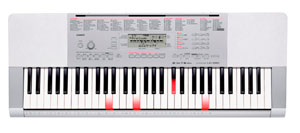Hands-on Review: CASIO LK-280 keyboard
(mtebaldi | Posted 2011-10-18)

From cash registers to watches, cell phones and cameras, CASIO does it all. In the spirit to cover a broad demographic, this Japanese founded company also offers a wide variety of keyboards and digital pianos for all tastes and skill levels. This summer CASIO unveiled three new models to their already extensive cataloge. The CTK-4200, WK-225 and LK-280. Three new keyboards built to serve the entry-level players out there. The LK-280 differentiates itself from the other two with more than system options and number of keys. The LK-280 is CASIO’s new addition to their Lighted Keys selection, designed specifically to facilitate the quick learning and eventual mastering of this instrument (if an instrument can ever truly be “mastered”). The LK-280 came my way this month and here are some of my thoughts about this new CASIO product.
Overview – The Casio LK-280 blends the portability of an entry-level keyboard with the quality and a few features normally found only on more professional units. It comes with 61 light-up keys, 600 built-in tones, including diverse pianos, organs, synths, percussion, and orchestral instruments. The LK-280 comes with an USB port for MIDI operations, SD card slot for storage and can be powered by AC or batteries. A center display exhibits staves notation, fingering and keys that are being pressed, and overall emphasizes the experience for those looking to use the LK-280 as a learning tool. This new Casio addition also allows players to record up to 5 songs with 6 tracks each, layer two different tones, offers the ability to choose different tones for bass and treble keys, sampling capabilities for up to 5 sounds, as well as boasts an arpeggiator feature and 180 built-in rhythms and accompaniments. The LK-280 also comes with two song transcription books that assist the integrated step-up lesson system.
Pros – The first impression I got from the LK-280 happened was overall good, and occurred when I first pressed down a few chords. The keys on this keyboard have a great feeling and weight; similar to a professional keyboard and definitely better than many keyboards out there that fall into the same price range. The piano sound quality is really great, mimicking the real instrument very well. The LK-280 features a button switch to toggle between the piano and organ tones, which is a interesting and useful feature especially for those who are mainly looking to use these two tones when playing this unit, for instance, church musicians. After a deeper look in the sound library and I found myself very impressed with the variety and quality of each of the tones. I’m thinking you won’t get bored easily due to any lack of sounds available to you on the LK-280. For beginners, the LK-280 will also prove extremely helpful with its array of accompaniments and especially with its built in keyboard lesson methods. There is even a music challenge mode where you will be able to explore your newly attained knowledge. With a built in chord book and its illuminated keys, learning to play and even master this instrument can be progressed much more quickly with the use of the LK-280. Its display showing notation and fingering also motivates and strengthens ones music theory, reading, and writing. The built in speakers, its light weight, and the capabilities of being powered by batteries, makes the LK-280 extremely portable and ready to be used in many different situations. I also loved its sampling (allowing for you to create and save up to 5 new tones in its memory) and arpeggiator capabilities, which can serve for further sonic exploration, motivating creativity and experimentation. If the illuminated keys are bothering you after a while, or you fear they will make you appear amateur in the presence of an audience, you can simply turn them off and be ready to show off your skills. The LK-280 also comes with two songbooks with a wide array range of music to play ranging in difficulty, from Twinkle-Twinkle Little Star to Beethoven’s Per Elise.
Cons – For its affordable price and semi professional features, it was a bit hard to find a negative side on the LK-280. But unfortunately, there was at least one. The display does not light up. It seems a bit strange to me to have brightly lit keys, while being unable to see the keyboard display in a dark room. It is sometimes a bit difficult to navigate through its library and setting in a bright room already, so just imagine if you intend to use the LK-280 to perform in a dimmed room. Make sure you always have a lamp nearby your LK-280.
Who will like - Perfect for students. Instructors and parents will easily see the LK-280 as a great aide tool for development of one’s keyboard playing skills.
Who won’t - I’m sure you won’t see Casio’s LK-280 as part of Jordan Rudess’ gear.
Specs -
61 note, touch response, piano style keyboard with light-up keys
600 Built-in tones including stereo pianos
180 Rhythm & accompaniment patterns
48 Note polyphony
SD card storage
Large backlit display with notation and fingering display
Integrated step-up lesson system
5 Song, 6 track recorder
Class compliant USB MIDI port
1/8" Audio line input
Headphone output
Power adapter included
Price = $199
Discuss this article with MGR readers. Join our forum here.


